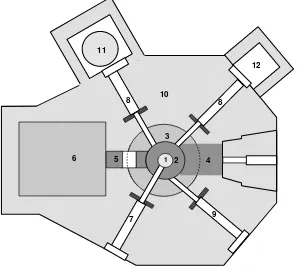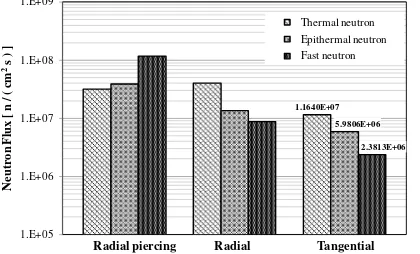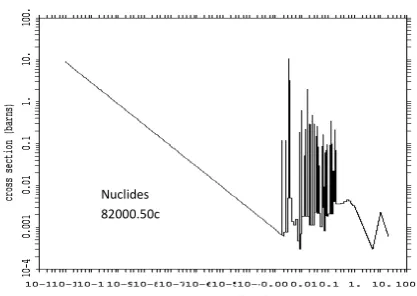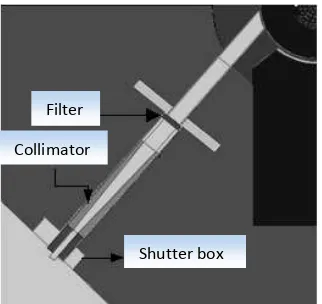107
PEMODELAN BERKAS UNTUK FASILITAS PGNAA PADA REAKTOR KARTINI
Tegas Sutondo
Center for Accellerator Science and Technology (CAST), BATAN Jl. Babarsari, P.O. Box 6101 ykbb, Yogyakarta 55281
e-mail: [email protected]; [email protected]
Received 25 May 2016, received in revised form 17 July 2015, accepted 30 July 2015
ABSTRACT
BEAM MODELING FOR PGNAA EXPERIMENTAL FACILITY AT KARTINI REACTOR. A feasibility study on
possible use of Kartini reactor’s beam port for Prompt Gamma Neutron Activation Analysis (PGNAA) experimental facility is going on. This work is part of the revitalization program activities of Kartini research reactor, including utilization of the available irradiation facilities. This paper presents results of beam modeling at the tangential beam port to get neutron beam meeting the specified criteria. The study was conducted by means of simulations using MCNPX code. The result concludes that there are several possible variations of collimator models that can provide neutron beam meeting the specified criteria and that tangential beam port is considered to be feasible enough for the purpose of PGNAA experimental facility
Keywords: beam, modeling, PGNAA, facility, Kartini reactor.
ABSTRAK
PEMODELAN BERKAS UNTUK FASILITAS PGNAA PADA REAKTOR KARTINI. Pada saat ini sedang
dilakukan studi kelayakan terkait kemungkinan penggunaan beam port dari reaktor Kartini untuk sarana eksperimen Prompt Gamma Neutron Activation Analysis (PGNAA). Kegiatan ini bagian dari program revitalisasi dari reaktor Kartini, termasuk pemanfaatan fasilitas irradiasi yang ada. Makalah ini menyajikan hasil dari pemodelan berkas pada beam port singgung untuk mendapatkan berkas neutron sesuai dengan persyaratan yang ditetapkan. Studi ini dilakukan berdasarkan dengan cara simulasi menggunakan program PCNPX. Dari hasil simulasi dapat disimpulkan bahwa ada beberapa variasi model kolimator yang dapat menghasilan berkas neutron sesuai kriteria yang ditetapkan, dan beam port singgung cukup layak untuk digunakan sebagai fasilitas eksperimen PGNAA.
Kata kunci: pemodelan, berkas, fasilitas. PGNAA, reaktor Kartini.
INTRODUCTION
artini reactor is a pool type TRIGA mark II reactor, operated with nominal power of 100 kW, and equipped with several irradiation facilities, including 4 beam ports that can be used for many different applications, as shown in Figure 1.
Figure 1. Horizontal cut view of Kartini Reactor.
108
Among the irradiation facilities available, Lazy Susan is being the most frequently used for elemental analysis, based on the Neutron Activation Analysis (NAA) techniques, which is known as DGNAA (Delayed Gamma Neutron Activation Analysis).
In conjunction with the revitalization program of Kartini reactor, there is interest to build a PGNAA experimental facility by utilizing one of the beam ports which are still not utilized optimally, i.e. radial piercing, radial and tangential beam ports. PGNAA is another variant of NAA techniques, working based on the gamma rays emitted promptly following the decay of the compound nucleus (CN) formed in the excited state. The intensity of the gamma-rays emitted is directly proportional to isotopic (elemental) concentrations. This technique has enabled the in situ and on-line application such as those used in coal mining; cement industries, etc. (1-4).
PGNAA technique, basically can work with the whole range of neutron energy spectrum, depending on the neutronic properties of the sample to be analyzed. However for most research application it is preferred to use neutrons of lower energy range, since activation reactions occur mostly with neutrons of low energies. An exception is for nuclides having very low thermal neutron capture reaction such as carbon, it is preferred to use fast neutron, throughout the neutron inelastic scattering reaction (2).
For PGNAA working with thermal neutron, the contribution of epithermal activation reactions, may affect the accuracy of the result, and therefore it should be minimized as much as possible to a reasonable level. This commonly indicated with the amount of thermal over epithermal neutron fluxes ratio (f), implying that the higher the value of f will be the better the quality of the neutron beam accordingly. A minimum f value of 100 was considered to be reasonable, with minimum thermal neutron flux = 1.0 106 n cm-2 s-1(5). In this respect, attempt will be made to get neutron beam meeting the above criteria.
A preliminary study has been carried out by characterizing the three kinds of beam port to select the most suitable one which is going to be used; i.e. the radial piercing and tangential beam port (6) and then also to include the radial beam port which was previously used for neutron radiography experimental facility. The study was performed by means of simulation using MCNPX code. Figure 2 summaries results of simulation of the neutron beam at the beam ports exit and Figure 3 is the corresponding radiation dose of both neutron and photon radiation.
1.1640E+07
The result shows that the radial piercing beam port provides the highest value of neutron fluxes. The photon radiation dose is also very high which is comparable with that of radial beam port. The high intensity of both fast neutrons and photons would need more works to do for both moderating the fast neutrons and suppressing the gamma rays as well. Radial beam port seen to give highest thermal neutron compared with the others, however the gamma rays radiation dose is of the same order with that of radial piercing beam port.
109
Figure 4. Inner and outer sections of tangential beam port.
METHODOLOGY
There are many different models of collimator having been developed, for several different applications (7-11). In this study, a basic geometrical model of collimator as represented in Figure 5 was used. The collimator consists of three main sections i.e. inner, middle and outer sections each with the length of L-1, L-2, and L-3 respectively.
Outer section
Figure 5. Basic shape of the collimator model.
The goal of this work is to suppress the gamma rays component to a reasonable level that can help simplify the problem of shielding and to get neutron beam meeting the defined criteria. This will be performed by means of selecting the suitable materials and adjusting the dimensions of each collimator section. For this purpose, it will be prioritized to use materials available in local market and relatively inexpensive.
Lead (Pb), with density of 11.34 g/cm3 is good for suppressing gamma rays, and it has also low neutron capture cross section which is relatively transparent against neutron passage (12, 13). In this respect, it will be used for the main component of collimator wall.
Another material having similar properties with lead is bismuth (Bi) with density of 9.780 g/cm3. It has low neutron capture cross section and high neutron elastic cross section that can improve the neutron transmission. In this respect, it will be included as part of evaluation for material of filter, inner and or outer sections wall.
Polyethylene of high density (HDPE) with density of 0.95 g/cm3 has low neutron capture cross section and high elastic scattering cross section which could improve the moderation of fast neutrons. It was also included in the evaluation for material of inner and outer section wall to help increase the thermal neutron production.
All of the above materials are easily obtained in local market and relatively inexpensive. Figure 6, 7, and 8 shows the MCNPX plot of neutron capture cross sections of lead, bismuth and HDPE respectively and Fig. 9, 10, 11 are the corresponding elastic scattering cross sections.
110
Figure 8. Neutron capture cross section of HDPE. Figure 9. Neutron elastic cross section of lead.
Figure 6. Neutron capture cross section of lead. Figure 7. Neutron capture cross section of bismuth.
Figure 10. Neutron Elastic cross section of bismuth. Figure 11. Neutron elastic cross section of HDPE. Nuclides
1001.50c 6012.50c
Nuclides 83209.60c
Nuclides 82000.50c Nuclides
1001.50c 6012.50c Nuclides 82000.50c
111 Several cases of simulation had been exercised based on the basic collimator model as represented by Figure 5. Figure 12 shows a piece of MCNP geometrical representation of a collimator model placed at the outer section of the tangential beam port.
Table 1 presents results of several cases of simulation using filter material of either lead or bismuth, with the same thickness of 5.0 cm, which can provide neutron beam at the exit, meeting the minimum defined criteria.
In case-1, the filter and the wall of collimator sections all use material of lead. Based on the prescribed collimator dimensions the photons and the epithermal and fast neutrons can be removed from the beam at the exit. The thermal flux obtained is still higher than the defined minimum value of 1.0 106 n cm-2 s-1 (5).
In case-2, the filter material was replaced by bismuth (Bi) and the length of inner section (L-1) was extended by 10 cm, (which result in the reduction of L-2 by 10 cm). This way could result in the increase of thermal neutron flux, but then with the presence of fast neutrons component. The presence of fast neutron theoretically would not give a significant contribution to the accuracy of the PGNAA since the activation cross section is much lower than that of thermal neutron. However, if most of fast neutron energies close to the upper limit of epithermal energy, it could affect the accuracy of the result.
In case-3, simulation was made by replacing the material of inner section wall with bismuth and outer section wall with HDPE, whilst keeping the dimensions unchanged. This way could remove the fast neutron component, but with a bit appearance of gamma rays which can then be removed by slightly reducing the outer radius of aperture as seen in case-4. The thermal neutron beam obtained represents the average value of several repeated simulation results, with relative differences of around 13%. However more repetitions of the simulations might still be needed to get the best representing result. This value seen to be much higher compared with that obtained in case-1 which used lead for both filter and all sections of the collimator wall.
Table 1. Result of simulations.
Cases of Simulation Case - 1 Case - 2 Case - 3 Case - 4
Filter Thickness (cm) 5.0 5.0 5.0 5.0
Material
Filter Lead Bismuth Bismuth Bismuth
Inner section Lead Lead Bismuth Bismuth
Middle section Lead Lead Lead Lead
Outer section Lead Lead HDPE HDPE
Figure 12. Piece of the MCNP representation of collimator model. Collimator
Filter
112
A series of simulation cases of beam modeling have been carried out as part of feasibility study on using
Kartini reactor’s beam port for PGNAA experimental facility. Tangential beam port has been selected for the
purpose of this study. The study was conducted by means of simulation using MCNPX code. Results of simulation indicate that there are several possible variations of collimator models that can provide neutron beam meeting the specified criteria. Based on the simulation results, it is concluded that the tangential beam port is feasible enough for the proposed of PGNAA application with the neutron beam at the beam port exit meets the specified criteria.
ACKNOWLEDGMENT
The author would like to thank to Director of CAST-BATAN Yogyakarta, Prof. Sudjatmoko, Prof. Syarip, the manager and the project coordinator for their great supports.
REFERENCES
1. DARIUSH REZAI, MOHAMMAD MOHAMMADI, Prompt Gamma Neutron Activation Analysis of Carbon Bulk Samples with an Am-Be Neutron Source, JTPC, Vol. 1 (2012) 11-13
2. TAREK Q. QASIM, TAWFEQ AL-ETAIWI, MOHAMMED AL-KHASHEB, “Analysis and Developments of PGNAA Installation at Al-Rashadiya Lafarge Cement Plant in Jordan”, Proceedings of the 2011 International Conference on Industrial Engineering and Operations Management, Kuala Lumpur, Malaysia, January 22 – 24, (2011) 1219-1224
3. DARRELL LEETHAM, PGNAA Improves Process and Quality Control in Cement Production, Accelerating Science, (2014)
4. AKHTAR ABBAS NAQVI, et al, Prompt Gamma-Ray Analysis of Steel Slag in Concrete, Journal of Nuclear Science and Technology, 46:7, Published online: 19 Mar (2012) 737-743
5. ALEXANDRE SOARES LEAL*, DANIEL CAMPOLINA, ZSOLTREVAY, “Feasibility Of The Prompt-Gamma Neutron Activation Analysis Facility At Trigaipr-R1 Reactor In Brazil”, International conference on research reactor safe management and effective utilization, Proceeding IAEA-CN-188-A19, Rabat Morocco 14-18 November (2011) 1-8
6. TEGAS SUTONDO and SYARIP, Karakteristik Berkas Pada Beam Port Tembus dan Singgung Reaktor Kartini, “Ganendra” Journal of Nuclear Science and Technology, Vol. 17 No. 2 (2014) 83-90
113 Chinese Physics C, Vol. 33, No 1, (2013) 010201, 1-5
9. J. G. FANTIDIS, et al, A transportable neutron radiography system, J Radioanal Nucl Chem 284 (2010): 479–484
10. FATEMEH SADAT RASOULI, SEYED FARHAD MASOUDI, Simulation of the BNCT of Brain Tumors Using MCNP Code: Beam Designing and Dose Evaluation, Iranian Journal of Medical Physics Vol. 9, No. 3 (2012) 183-192
11. VICTOR KREFT, Studies Towards Boron Neutron Capture Synovectomy At Mcmaster University, A Thesis Submitted to the School of Graduate Studies in Partial Fulfillment of the Requirements for the Degree Doctor of Philosophy, McMaster University, Hamilton, Ontario (2014). https://macsphere.mcmaster.ca/handle/11375/
16157, down loaded on February 6, (2015)
12. N. SHMELEV, G. G. KULIKOV, V. A. APSE, E. G. KULIKOV, AND V. V. ARTISYUK, Radiogenic Lead with Dominant Content of 208Pb: New Coolant and Neutron Moderator for Innovative Nuclear Facilities, Hindawi Publishing Corporation, Science and Technology of Nuclear Installations Volume (2011) 1-12
13. Liquid Metal Coolants For Fast Reactors Cooled By Sodium, Lead, And Lead-Bismuth Eutectic, IAEA Nuclear Energy Series No. Np-T-1.




